German Barquero
From Sparse Signal to Smooth Motion: Real-Time Motion Generation with Rolling Prediction Models
Apr 07, 2025Abstract:In extended reality (XR), generating full-body motion of the users is important to understand their actions, drive their virtual avatars for social interaction, and convey a realistic sense of presence. While prior works focused on spatially sparse and always-on input signals from motion controllers, many XR applications opt for vision-based hand tracking for reduced user friction and better immersion. Compared to controllers, hand tracking signals are less accurate and can even be missing for an extended period of time. To handle such unreliable inputs, we present Rolling Prediction Model (RPM), an online and real-time approach that generates smooth full-body motion from temporally and spatially sparse input signals. Our model generates 1) accurate motion that matches the inputs (i.e., tracking mode) and 2) plausible motion when inputs are missing (i.e., synthesis mode). More importantly, RPM generates seamless transitions from tracking to synthesis, and vice versa. To demonstrate the practical importance of handling noisy and missing inputs, we present GORP, the first dataset of realistic sparse inputs from a commercial virtual reality (VR) headset with paired high quality body motion ground truth. GORP provides >14 hours of VR gameplay data from 28 people using motion controllers (spatially sparse) and hand tracking (spatially and temporally sparse). We benchmark RPM against the state of the art on both synthetic data and GORP to highlight how we can bridge the gap for real-world applications with a realistic dataset and by handling unreliable input signals. Our code, pretrained models, and GORP dataset are available in the project webpage.
MixerMDM: Learnable Composition of Human Motion Diffusion Models
Apr 01, 2025Abstract:Generating human motion guided by conditions such as textual descriptions is challenging due to the need for datasets with pairs of high-quality motion and their corresponding conditions. The difficulty increases when aiming for finer control in the generation. To that end, prior works have proposed to combine several motion diffusion models pre-trained on datasets with different types of conditions, thus allowing control with multiple conditions. However, the proposed merging strategies overlook that the optimal way to combine the generation processes might depend on the particularities of each pre-trained generative model and also the specific textual descriptions. In this context, we introduce MixerMDM, the first learnable model composition technique for combining pre-trained text-conditioned human motion diffusion models. Unlike previous approaches, MixerMDM provides a dynamic mixing strategy that is trained in an adversarial fashion to learn to combine the denoising process of each model depending on the set of conditions driving the generation. By using MixerMDM to combine single- and multi-person motion diffusion models, we achieve fine-grained control on the dynamics of every person individually, and also on the overall interaction. Furthermore, we propose a new evaluation technique that, for the first time in this task, measures the interaction and individual quality by computing the alignment between the mixed generated motions and their conditions as well as the capabilities of MixerMDM to adapt the mixing throughout the denoising process depending on the motions to mix.
in2IN: Leveraging individual Information to Generate Human INteractions
Apr 15, 2024



Abstract:Generating human-human motion interactions conditioned on textual descriptions is a very useful application in many areas such as robotics, gaming, animation, and the metaverse. Alongside this utility also comes a great difficulty in modeling the highly dimensional inter-personal dynamics. In addition, properly capturing the intra-personal diversity of interactions has a lot of challenges. Current methods generate interactions with limited diversity of intra-person dynamics due to the limitations of the available datasets and conditioning strategies. For this, we introduce in2IN, a novel diffusion model for human-human motion generation which is conditioned not only on the textual description of the overall interaction but also on the individual descriptions of the actions performed by each person involved in the interaction. To train this model, we use a large language model to extend the InterHuman dataset with individual descriptions. As a result, in2IN achieves state-of-the-art performance in the InterHuman dataset. Furthermore, in order to increase the intra-personal diversity on the existing interaction datasets, we propose DualMDM, a model composition technique that combines the motions generated with in2IN and the motions generated by a single-person motion prior pre-trained on HumanML3D. As a result, DualMDM generates motions with higher individual diversity and improves control over the intra-person dynamics while maintaining inter-personal coherence.
Seamless Human Motion Composition with Blended Positional Encodings
Feb 23, 2024



Abstract:Conditional human motion generation is an important topic with many applications in virtual reality, gaming, and robotics. While prior works have focused on generating motion guided by text, music, or scenes, these typically result in isolated motions confined to short durations. Instead, we address the generation of long, continuous sequences guided by a series of varying textual descriptions. In this context, we introduce FlowMDM, the first diffusion-based model that generates seamless Human Motion Compositions (HMC) without any postprocessing or redundant denoising steps. For this, we introduce the Blended Positional Encodings, a technique that leverages both absolute and relative positional encodings in the denoising chain. More specifically, global motion coherence is recovered at the absolute stage, whereas smooth and realistic transitions are built at the relative stage. As a result, we achieve state-of-the-art results in terms of accuracy, realism, and smoothness on the Babel and HumanML3D datasets. FlowMDM excels when trained with only a single description per motion sequence thanks to its Pose-Centric Cross-ATtention, which makes it robust against varying text descriptions at inference time. Finally, to address the limitations of existing HMC metrics, we propose two new metrics: the Peak Jerk and the Area Under the Jerk, to detect abrupt transitions.
REACT 2024: the Second Multiple Appropriate Facial Reaction Generation Challenge
Jan 10, 2024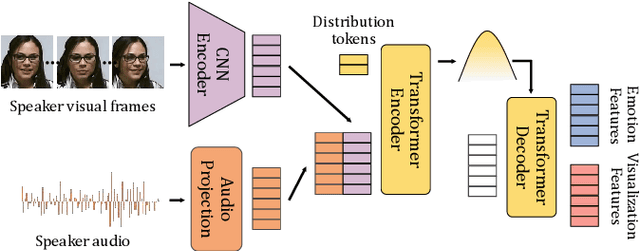
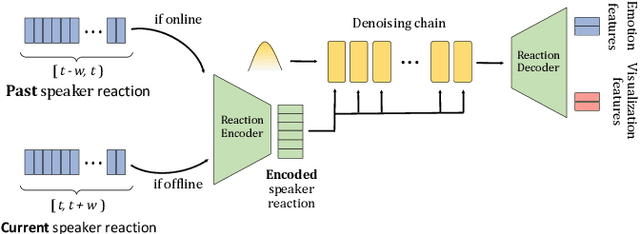
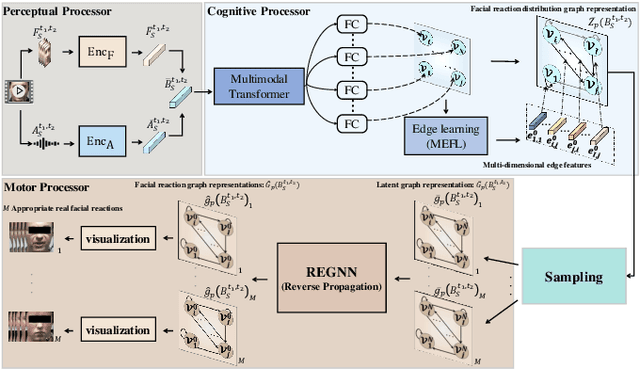
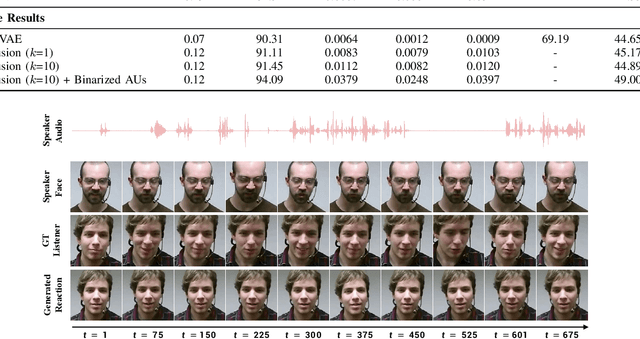
Abstract:In dyadic interactions, humans communicate their intentions and state of mind using verbal and non-verbal cues, where multiple different facial reactions might be appropriate in response to a specific speaker behaviour. Then, how to develop a machine learning (ML) model that can automatically generate multiple appropriate, diverse, realistic and synchronised human facial reactions from an previously unseen speaker behaviour is a challenging task. Following the successful organisation of the first REACT challenge (REACT 2023), this edition of the challenge (REACT 2024) employs a subset used by the previous challenge, which contains segmented 30-secs dyadic interaction clips originally recorded as part of the NOXI and RECOLA datasets, encouraging participants to develop and benchmark Machine Learning (ML) models that can generate multiple appropriate facial reactions (including facial image sequences and their attributes) given an input conversational partner's stimulus under various dyadic video conference scenarios. This paper presents: (i) the guidelines of the REACT 2024 challenge; (ii) the dataset utilized in the challenge; and (iii) the performance of the baseline systems on the two proposed sub-challenges: Offline Multiple Appropriate Facial Reaction Generation and Online Multiple Appropriate Facial Reaction Generation, respectively. The challenge baseline code is publicly available at https://github.com/reactmultimodalchallenge/baseline_react2024.
REACT2023: the first Multi-modal Multiple Appropriate Facial Reaction Generation Challenge
Jun 11, 2023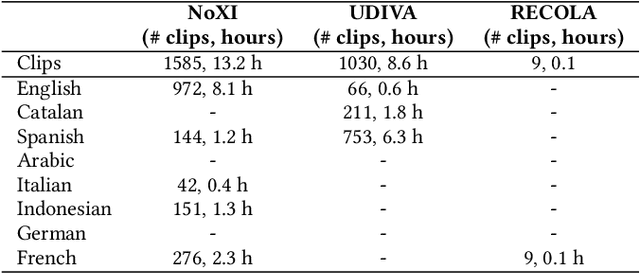
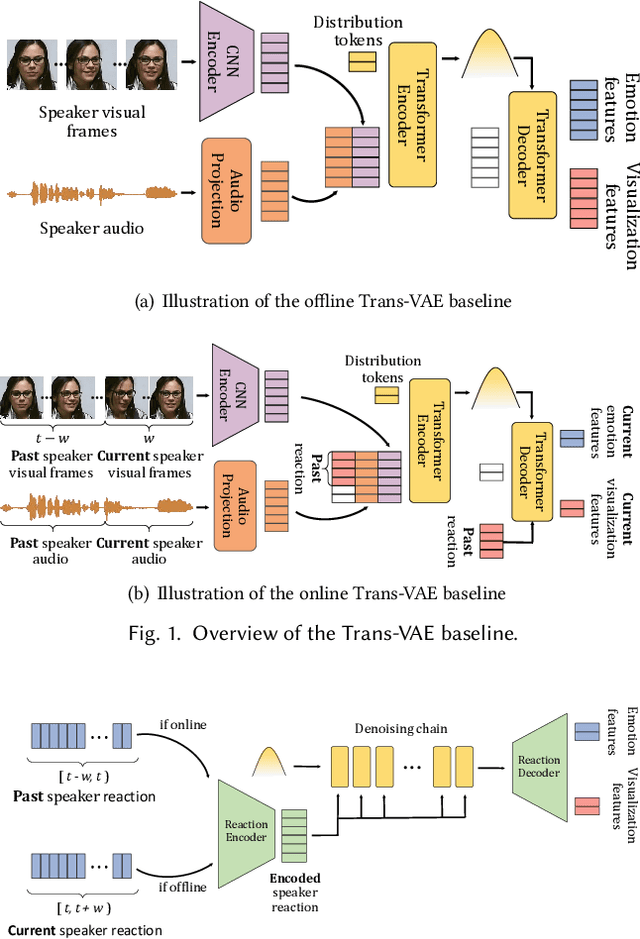
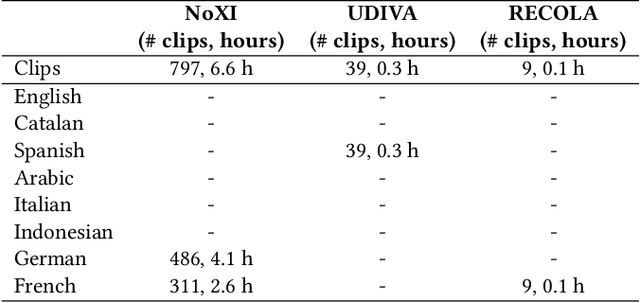
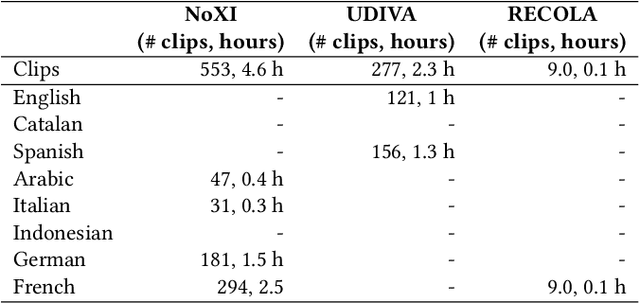
Abstract:The Multi-modal Multiple Appropriate Facial Reaction Generation Challenge (REACT2023) is the first competition event focused on evaluating multimedia processing and machine learning techniques for generating human-appropriate facial reactions in various dyadic interaction scenarios, with all participants competing strictly under the same conditions. The goal of the challenge is to provide the first benchmark test set for multi-modal information processing and to foster collaboration among the audio, visual, and audio-visual affective computing communities, to compare the relative merits of the approaches to automatic appropriate facial reaction generation under different spontaneous dyadic interaction conditions. This paper presents: (i) novelties, contributions and guidelines of the REACT2023 challenge; (ii) the dataset utilized in the challenge; and (iii) the performance of baseline systems on the two proposed sub-challenges: Offline Multiple Appropriate Facial Reaction Generation and Online Multiple Appropriate Facial Reaction Generation, respectively. The challenge baseline code is publicly available at \url{https://github.com/reactmultimodalchallenge/baseline_react2023}.
BeLFusion: Latent Diffusion for Behavior-Driven Human Motion Prediction
Nov 25, 2022Abstract:Stochastic human motion prediction (HMP) has generally been tackled with generative adversarial networks and variational autoencoders. Most prior works aim at predicting highly diverse movements in terms of the skeleton joints' dispersion. This has led to methods predicting fast and motion-divergent movements, which are often unrealistic and incoherent with past motion. Such methods also neglect contexts that need to anticipate diverse low-range behaviors, or actions, with subtle joint displacements. To address these issues, we present BeLFusion, a model that, for the first time, leverages latent diffusion models in HMP to sample from a latent space where behavior is disentangled from pose and motion. As a result, diversity is encouraged from a behavioral perspective. Thanks to our behavior coupler's ability to transfer sampled behavior to ongoing motion, BeLFusion's predictions display a variety of behaviors that are significantly more realistic than the state of the art. To support it, we introduce two metrics, the Area of the Cumulative Motion Distribution, and the Average Pairwise Distance Error, which are correlated to our definition of realism according to a qualitative study with 126 participants. Finally, we prove BeLFusion's generalization power in a new cross-dataset scenario for stochastic HMP.
Comparison of Spatio-Temporal Models for Human Motion and Pose Forecasting in Face-to-Face Interaction Scenarios
Mar 07, 2022



Abstract:Human behavior forecasting during human-human interactions is of utmost importance to provide robotic or virtual agents with social intelligence. This problem is especially challenging for scenarios that are highly driven by interpersonal dynamics. In this work, we present the first systematic comparison of state-of-the-art approaches for behavior forecasting. To do so, we leverage whole-body annotations (face, body, and hands) from the very recently released UDIVA v0.5, which features face-to-face dyadic interactions. Our best attention-based approaches achieve state-of-the-art performance in UDIVA v0.5. We show that by autoregressively predicting the future with methods trained for the short-term future (<400ms), we outperform the baselines even for a considerably longer-term future (up to 2s). We also show that this finding holds when highly noisy annotations are used, which opens new horizons towards the use of weakly-supervised learning. Combined with large-scale datasets, this may help boost the advances in this field.
* single column, 27 pages, 7 figures, 7 tables
Didn't see that coming: a survey on non-verbal social human behavior forecasting
Mar 04, 2022



Abstract:Non-verbal social human behavior forecasting has increasingly attracted the interest of the research community in recent years. Its direct applications to human-robot interaction and socially-aware human motion generation make it a very attractive field. In this survey, we define the behavior forecasting problem for multiple interactive agents in a generic way that aims at unifying the fields of social signals prediction and human motion forecasting, traditionally separated. We hold that both problem formulations refer to the same conceptual problem, and identify many shared fundamental challenges: future stochasticity, context awareness, history exploitation, etc. We also propose a taxonomy that comprises methods published in the last 5 years in a very informative way and describes the current main concerns of the community with regard to this problem. In order to promote further research on this field, we also provide a summarised and friendly overview of audiovisual datasets featuring non-acted social interactions. Finally, we describe the most common metrics used in this task and their particular issues.
* single column, 27 pages, 4 figures, 3 tables
 Add to Chrome
Add to Chrome Add to Firefox
Add to Firefox Add to Edge
Add to Edge